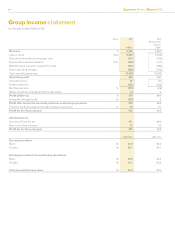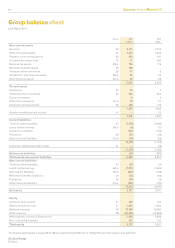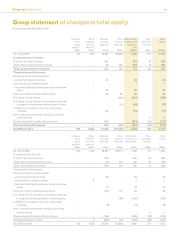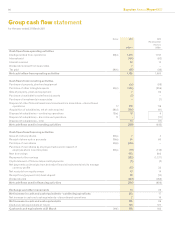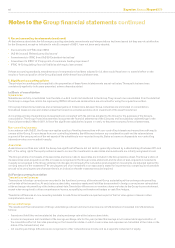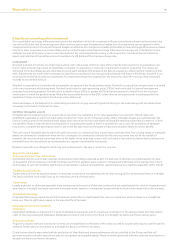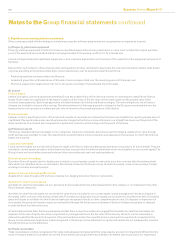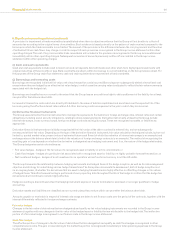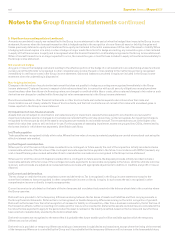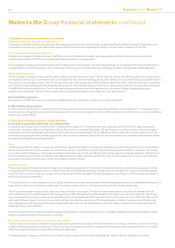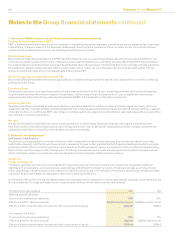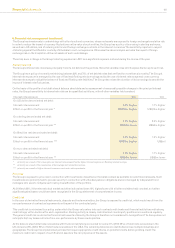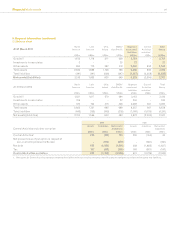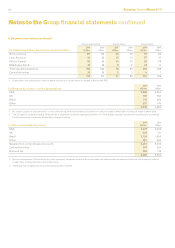Experian 2011 Annual Report Download - page 104
Download and view the complete annual report
Please find page 104 of the 2011 Experian annual report below. You can navigate through the pages in the report by either clicking on the pages listed below, or by using the keyword search tool below to find specific information within the annual report.
102 Experian Annual Report 2011
Notes to the Group nancial statements continued
5. Signicant accounting policies (continued)
Amounts accumulated in equity are reclassied in the Group income statement in the period when the hedged item impacts the Group income
statement. However, when the forecast transaction that is hedged results in the recognition of a non-nancial asset or liability, the gains and
losses previously deferred in equity are transferred from equity and included in the initial measurement of the cost of the asset or liability. When
a hedging instrument expires or is sold, or when a hedge no longer meets the criteria for hedge accounting, any cumulative gain or loss included
in equity at that time remains in equity and is recognised when the forecast transaction is ultimately recognised in the Group income statement.
When a forecast transaction is no longer expected to occur, the cumulative gain or loss that was included in equity is transferred immediately to
the Group income statement.
Net investment hedges
Any gain or loss on the hedging instrument relating to the effective portion of the hedge of a net investment in an undertaking whose functional
currency is not the US dollar is recognised in other comprehensive income; the gain or loss relating to the ineffective portion is recognised
immediately in net nance costs in the Group income statement. Gains and losses accumulated in equity are included in the Group income
statement when the undertaking is disposed of.
Non-hedging derivatives
Changes in the fair value of any derivative instrument that does not qualify for hedge accounting are recognised immediately in the Group
income statement. Costs and income in respect of derivatives entered into in connection with social security obligations on employee share
incentive plans, other than those of a nancing nature, are charged or credited within labour costs; other costs and changes in fair value on such
derivatives are charged or credited within nancing fair value remeasurements in the Group income statement.
Derivatives embedded in other nancial instruments or other host contracts are treated as separate derivatives when their risks and
characteristics are not closely related to those of host contracts, and the host contracts are not carried at fair value with unrealised gains or
losses reported in the Group income statement.
(l) Impairment of non-nancial assets
Assets that are not subject to amortisation are tested annually for impairment. Assets that are subject to amortisation are reviewed for
impairment whenever events or changes in circumstances indicate that the carrying amount may not be recoverable. An impairment charge is
recognised for the amount by which the asset’s carrying amount exceeds its recoverable amount. The recoverable amount is the higher of an
asset’s fair value less costs to sell, and value-in-use. For the purposes of assessing impairment, assets are grouped into CGUs, determined by
the lowest levels for which there are separately identiable cash ows.
(m) Trade payables
Trade payables are recognised initially at fair value. Where the time value of money is material, payables are carried at amortised cost using the
effective interest rate method.
(n) Contingent consideration
Where part or all of the amount of purchase consideration is contingent on future events, the cost of the acquisition initially recorded includes
a reasonable estimate of the fair value of the contingent amounts expected to be payable in the future. In accordance with IFRS 3 (revised), any
cost or benet arising when revised estimates of such consideration are made is now recognised in the Group income statement.
Where part or all of the amount of disposal consideration is contingent on future events, the disposal proceeds initially recorded include a
reasonable estimate of the fair value of the contingent amounts expected to be receivable and payable in the future. Until the ultimate outcome
is known, such proceeds are adjusted as revised estimates are made with appropriate adjustments to debtors or creditors and prot or loss on
disposal.
(o) Current and deferred tax
The tax charge or credit for the year comprises current and deferred tax. Tax is recognised in the Group income statement, except to the
extent that it relates to items recognised in other comprehensive income or directly in equity. In such cases the tax is recognised in other
comprehensive income or directly in equity as appropriate.
Current income tax is calculated on the basis of the tax laws enacted or substantively enacted at the balance sheet date in the countries where
the Group operates.
Deferred tax is provided in full on temporary differences arising between the tax bases of assets and liabilities and their carrying amounts in
the Group nancial statements. Deferred tax is not recognised on taxable temporary differences arising on the initial recognition of goodwill.
Deferred tax that arises from the initial recognition of an asset or liability in a transaction, other than a business combination, that at the time of
the transaction affects neither accounting nor taxable prot or loss is not accounted for. Deferred tax assets and liabilities are calculated at the
tax rates that are expected to apply to the period when the asset is realised or the liability is settled, based on the tax rates and laws that have
been enacted or substantively enacted by the balance sheet date.
Deferred tax assets are recognised to the extent that it is probable that future taxable prot will be available against which the temporary
differences can be utilised.
Deferred tax is provided on temporary differences arising on investments in subsidiaries and associates, except where the timing of the reversal
of the temporary difference is controlled by the Group and it is probable that the temporary difference will not reverse in the foreseeable future.


